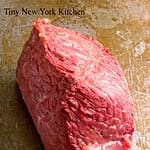It’s that time of year again, in America, when the beer turns green and the aroma of corned beef and cabbage fills the air. The dish is so comforting, but just what is corned beef? The term has nothing to do with corn, but was the English term for a small granule, such as a grain of salt. In days before modern refrigeration, salting meat was a way to preserve it and keep it from spoiling.
Corned beef is an Americanized addition to the traditional Irish diet. While colcannon (boiled potatoes, cabbage, and leeks in buttermilk flavored with wild garlic) was a common Irish dish, as was brown soda bread, corned beef was produced primarily for export to England. Upon arriving in America, however, it’s thought the Irish chose to celebrate their holiday with food that was typically not available to them in their home country, so corned beef was added to the menu, as was white soda bread studded with currants and caraway.
Corned beef is typically made from beef brisket, which is a cut of meat from the breast or lower chest, but the rump, bottom round, and even tongue, can be used. In America, the term “corned beef” is used to describe both the cured meat and the canned stuff found on grocery store shelves. In Britain, they call the canned stuff “salt beef.”
To make corned beef the meat is simmered in a blend of corned beef spices that usually include peppercorns, garlic, mustard, tarragon, thyme, parsley, cloves, and nutmeg.
In New England, you most often see corned beef served as a St. Patrick’s Day main dish or in a sandwich. As the main ingredient in New England Boiled Dinner, corned beef often pairs with potatoes, carrots, turnips, and cabbage in a hearty, savory, brothy bowl of goodness. When used in a sandwich, the most popular corned beef sandwich is the Reuben. Considered the quintessential Jewish deli sandwich, a Reuben is toasted rye bread stuffed with hot slices of corned beef, usually piled high, and topped with sauerkraut, Swiss cheese, and either Russian or Thousand Island dressing.
In New England, a frequent point of interest is also whether you prefer red vs. gray corned beef. The difference is “Red” brisket is cured with nitrite, which gives the meat its signature color. “Gray” corned beef, which is considered the authentic New England variety, is not cured with nitrate, so color forms naturally as it brines.
If you have corned beef leftovers a New England favorite is corned beef hash, which is typically served for breakfast.
“Work With What You Got!”
©Tiny New York Kitchen © 2018 All Rights Reserved
 Feast of Saint John The Baptist June 24th
Feast of Saint John The Baptist June 24th
One of the many unique things that we could say in describing St. John the Baptist is that he is truly the "Saint of Summer." Saint John the Baptist is one of the most important saints. Other than the Virgin Mary and St. Joseph, John the Baptist is the only saint who is honored on the Church calendar with more than one Feast Day (the other is August 29th, the day of his martyrdom). As we can see, both these Feast Days occur at the opposite ends of the Summer season. John the Baptist saw and lived very clearly his purpose in life and carried it out in the midst of challenges. He had two important qualities of his life that should inspire us each day.These two qualities are humility and a sense of purpose.
Son of Elizabeth and Zacharias, both already advanced in years and childless, John was born about 6 months before Jesus. This birth had been announced by the archangel Gabriel to Zacharias, who was struck dumb by the message. 8 days after the birth, having to be circumcised, the child needed a name, and Zacharias succeeded in writing “John,” following indications of the angel; his tongue loosened in the hymn of the Benedictus. In representations of the birth o the Baptist, Mary is usually also present, assist her cousin Elizabeth, while Zacharias is most often shown in the act of writing. The name John is from a Hebrew name meaning “Yahweh is gracious.”
This is a great feast of June that is common to countries and has been celebrated since early times, is the Nativity of Saint John the Baptist, also known as Midsummer. In lots of places bonfires are lighted in honor of Saint John. This day is to celebrate the summer solstice. In Ireland and in England these bonfires had their origin in the Druidic fires lighted in honor of the god of the sacred wood. Today they are known as the Fires of Saint John although a few pagan customs remain in connection with the celebration.
In France the bonfires are built as close as possible to one of Saint John’s own chapels. It is important to have a boy named Jean or a girl named Jeanne provides a wreath to throw into the fire. When vesper services are over the priest kindles the blaze and the evening begins with singing and dancing which will last far into the night.
In Mexico Saint John’s feast is a big affair. Saint John is the Mexicans dearly beloved saint, especially the saint of the waters. On this day wells and fountains are decorated bright with ribbons and flowers. At midnight on the eve, everyone bathes: in the country in lakes or pools or rivers; in large cities the festivities center around the fashionable bath houses where swimming contests and exhibitions of diving skill take place.
Saint John’s Day in Mexico is definitely also a day of feasting. Everyone brings food to the bathing places. Cakes, sweets, chicken tamales, stuffed peppers, pork tacos and empanadas.









